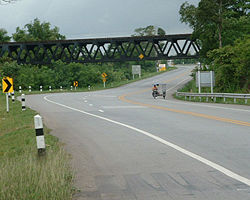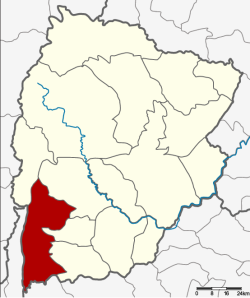Thep Sathit District
|
Thep Sathit เทพสถิต |
|
|---|---|
| Amphoe | |

The railway bridge of northeastern rail route crosses over Suranarai Road in Thep Sathit
|
|
 Amphoe location in Chaiyaphum Province |
|
| Coordinates: 15°23′30″N 101°27′0″E / 15.39167°N 101.45000°ECoordinates: 15°23′30″N 101°27′0″E / 15.39167°N 101.45000°E | |
| Country |
|
| Province | Chaiyaphum |
| Seat | Wa Tabaek |
| Area | |
| • Total | 875.6 km2 (338.1 sq mi) |
| Population (2005) | |
| • Total | 65,735 |
| • Density | 75.1/km2 (195/sq mi) |
| Time zone | THA (UTC+7) |
| Postal code | 36230 |
| Geocode | 3609 |
Thep Sathit (Thai: เทพสถิต, pronounced [tʰêːp sā.tʰìt]) is a district (amphoe) in the southwestern part of Chaiyaphum Province, eastern Thailand.
In the past time, it was just a small community of ancient Mon people.
The minor district (King Amphoe) Thep Sathit was created on November 1, 1976, when the three tambon Wa Tabaek, Na Yang Klak and Huai Yai Chio were split off from Bamnet Narong district. April 1, 1983 it was upgraded to a full district.
The western boundary of the district is formed by the steep Phang Hoei ridge, with its highest elevation at the Sut Phaen Din with 846m above sea level. To the east the terrain descends slowly towards the Khorat Plateau. The Pa Hin Ngam National Park, famous for its Siam Tulip fields, is located within the western hills of this district.
Neighboring districts are (from the north clockwise) Phakdi Chumphon, Nong Bua Rawe, Sap Yai, Bamnet Narong of Chaiyaphum Province, Thepharak of Nakhon Ratchasima Province, Lam Sonthi of Lopburi Province and Wichian Buri of Phetchabun Province.
...
Wikipedia
